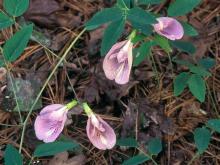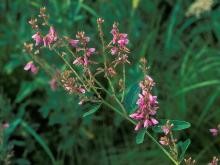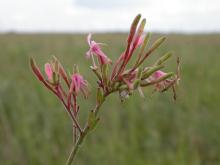Wildflowers, Grasses and Other Nonwoody Plants
Media

Species Types
Scientific Name
Chamaecrista fasciculata (formerly Cassia fasciculata)
Description
The interesting, bright yellow flowers of showy partridge pea are immediately recognizable. At night, the leaflets close and pull upward into a sleeping position.
Media

Species Types
Scientific Name
Kummerowia stipulacea (formerly Lespedeza stipulacea)
Description
Korean lespedeza is an Asian clover that was introduced to North America to prevent erosion, to feed wildlife and livestock, and, since it is a legume, to add nitrogen to the soil. A weedy plant, it has spread statewide since the 1930s.
Media

Species Types
Scientific Name
Melilotus albus and M. officinale
Description
These two species of sweet clover are present all over America. Although they have been planted for forage, as bee plants, and as nitrogen-fixers, white and yellow sweet clover are now classified as invasive for their weediness and the problems they pose for natural habitats.
Media

Species Types
Scientific Name
Stylosanthes biflora
Description
Pencil flower is small and often overlooked. It has wiry stems, long, bristly hairs, three-parted leaves, and orangish-yellow flowers.
Media

Species Types
Scientific Name
Monotropa hypopitys
Description
Pinesap is a plant that puts the "wild" in wildflower! It lacks chlorophyll, so its roots connect to fungi underground and absorb nutrients from the fungi.
Media

Species Types
Scientific Name
Cunila origanoides
Description
Sometimes called wild oregano, dittany, like true oregano, is a member of the mint family and can be used as a culinary herb and in teas. Look for it on dry, wooded slopes in Ozark counties.
Media

Species Types
Scientific Name
Clitoria mariana
Description
Butterfly pea is a low, shrubby, or twining perennial in the pea family, with showy, butterfly-like flowers. The leaves are compound with three leaflets. This species grows in the southern parts of Missouri, in acid soils.
Media

Species Types
Scientific Name
Scutellaria incana
Description
Showy clusters of blue-violet, two-lipped flowers adorn downy skullcap. This native mint is found mostly in the southern half of the state.
Media

Species Types
Scientific Name
Desmodium spp. (17 species in Missouri)
Description
Missouri has 17 species of tick trefoils, which live in a variety of habitats. Hikers know them well from their chains of hairy little seedpods that stick to clothing like parasites!
Media

Species Types
Scientific Name
Oenothera filiformis (formerly Gaura longiflora, G. biennis)
Description
Large-flowered gaura is a tall plant whose white flowers turn pinkish as they age. Four petals point upward, then bend back, and 8 stamens droop downward. The flowers look something like small butterflies.
See Also
About Wildflowers, Grasses and Other Nonwoody Plants in Missouri
A very simple way of thinking about the green world is to divide the vascular plants into two groups: woody and nonwoody (or herbaceous). But this is an artificial division; many plant families include some species that are woody and some that are not. The diversity of nonwoody vascular plants is staggering! Think of all the ferns, grasses, sedges, lilies, peas, sunflowers, nightshades, milkweeds, mustards, mints, and mallows — weeds and wildflowers — and many more!





















